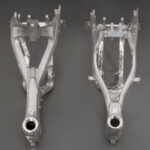Choosing the right bicycle lock can be overwhelming. With countless options available, making the wrong decision could lead to devastating consequences – bike theft. The key to securing your ride lies in finding a balance: a lock that is robust enough to deter thieves, yet practical enough for everyday use.
This equilibrium between security and usability is paramount. As someone who has rigorously tested bike locks and written extensively about bicycle security since 2015, I understand the nuances of effective bike protection.
Based on stringent security assessments and real-world user testing, I’ve compiled a list of 6 of the best bike locks currently available. These recommendations are based on their security ratings and my hands-on experience.
However, if these selections don’t perfectly align with your specific needs, don’t worry. Beyond these top picks, I’ll guide you through three simple steps (including a quick quiz to assess your risk level) to ensure you discover the ideal bike lock tailored to your individual requirements.
1. Litelok X1
In 2024, the Litelok X1 stands out as the best all-around bike lock. Its exceptional feature? The Litelok X1 is one of the few bike locks on the market that offers substantial protection against cordless angle grinder attacks.
In a time where angle grinder assaults are alarmingly prevalent, particularly in urban environments where they seem to be the tool of choice for bypassing flimsy cable locks, the Litelok X1 is a vital piece of security. Until recently, no bike lock could withstand an angle grinder for more than a minute. Locks like the Litelok X1 and the Hiplok D1000, capable of resisting such attacks, are now indispensable.
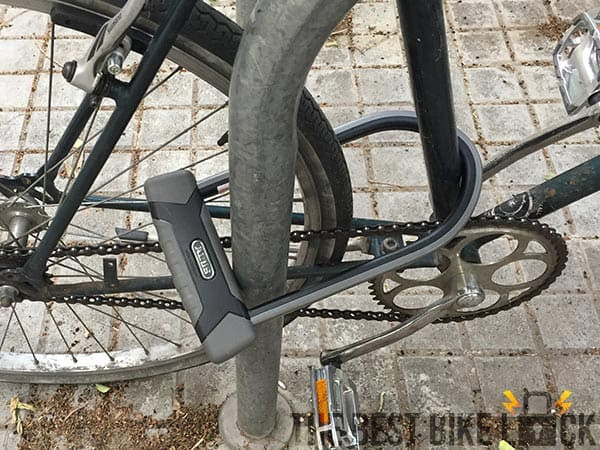 Litelok X1 on front wheel
Litelok X1 on front wheel
Litelok X1: the best all round good bike lock
What sets the Litelok X1 apart?
The Litelok X1 maintains the familiar form and function of a traditional u-lock. It’s marginally shorter than a standard u-lock, but the difference is negligible—less than 2 cm—ensuring it remains practical in daily use.
The key innovation lies within its construction. The Litelok X1 incorporates a ceramic composite material fused to its 16 mm shackle. This specialized material actively degrades angle grinder discs as they attempt to cut through the lock.
| Litelok X1 |
|---|
| My score: |
| Check price: |
| Shackle thickness: |
| Weight: |
| Size (internal): |
| Other Security Ratings: |
In my comprehensive tests, breaching one side of the Litelok X1 took over four times longer than defeating the Kryptonite New York Fahgettaboudit, which, until the arrival of the X1 and D1000, was considered the pinnacle of bike lock security.
In fact, during my initial test, I exhausted all my cutting discs before managing to cut through the Litelok X1, rendering it undefeated.
The Litelok X1’s performance has resonated beyond my own testing. It’s one of the select few bike locks, alongside other angle grinder resistant models, to achieve a Sold Secure Powered Cycle Diamond rating.
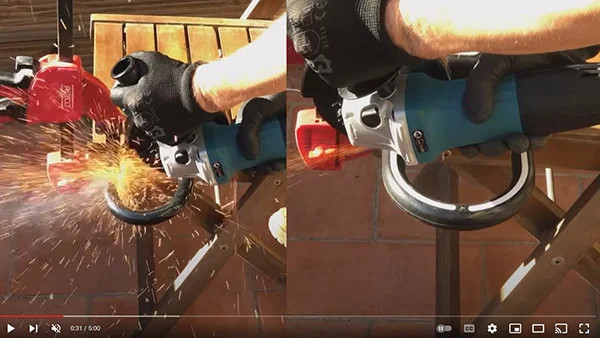 Litelok X1 test video still
Litelok X1 test video still
Watch my angle grinder test of the Litelok X1
Is it flawless? No.
Initially, my Litelok X1 presented some locking challenges, although a simple DIY fix resolved this quickly. I’ve been assured that the factory has since rectified this issue.
More importantly, it’s not as impregnable as the Hiplok D1000 (and DX1000), or the Litelok X3. These superior locks withstood grinder attacks for nearly 2.5 and 3 times longer per side, respectively, in my tests.
So, why isn’t the Hiplok D1000 or Litelok X3 my top recommendation for 2024? While both are exceptional locks, and arguably the most robust bike locks currently available, they come with significant drawbacks.
 Litelok X1 vs Litelok X3 vs Hiplok D1000
Litelok X1 vs Litelok X3 vs Hiplok D1000
Litelok X1 vs Litelok X3 vs Hiplok D1000
Their price is a major deterrent – they are considerably more expensive. They are also much heavier and less portable than the Litelok X1. Furthermore, the Hiplok D1000 is notably smaller than the Litelok X1, potentially limiting its versatility for some cyclists. (Note: the Hiplok DX1000 addresses this size issue).
The Litelok X1 strikes an optimal balance of security, practicality, and cost. Its convenient size, smart frame mount, and competitive price (only slightly more expensive than the Abus Granit X Plus 540 and about half the price of the Hiplok D1000!) make it the sensible choice for most cyclists seeking angle grinder resistance.
For a deeper dive, read my comprehensive Litelok X1 review, which includes a video comparing its angle grinder resistance to the Fahgettaboudit, or my comparison of the Litelok X1 vs Hiplok D1000.
Keep an eye on my page dedicated to angle grinder resistant bike locks, as new models are continuously being developed.
2. Kryptonite Kryptolok New-U
Angle grinder resistance isn’t a necessity for everyone. I strongly recommend taking my brief 3-question quiz to determine your personal risk level and ascertain if you truly need such advanced protection.
For those in lower-risk scenarios, the Kryptonite Kryptolok New-U, an enhanced iteration of the renowned Kryptolok Series 2, presents an excellent and affordable alternative.
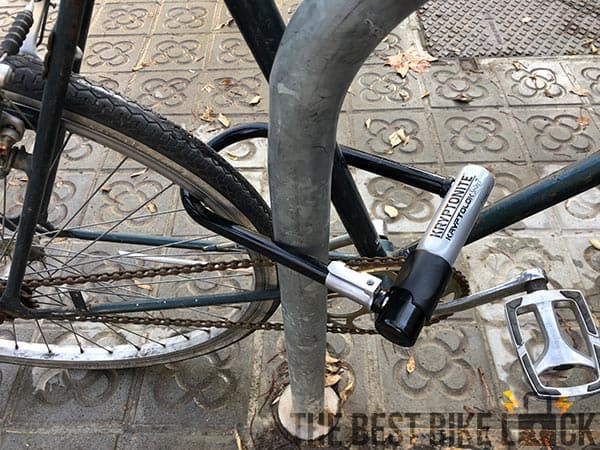 Kryptonite Kryptolok Standard: best medium security bike lock
Kryptonite Kryptolok Standard: best medium security bike lock
Kryptonite Kryptolok Standard: best medium security good bike lock
By refining the shackle to lock on both sides, unlike its predecessor, the Kryptolok has elevated its Sold Secure rating from Silver to Gold. However, its consistent 2/5 star rating from ART signifies it remains firmly in the medium-security category.
The Kryptolok’s appeal lies in its user-friendliness. It’s relatively lightweight, comparable to about 3.5 cans of soda. With proper frame mount attachment, it’s easily portable during rides.
Furthermore, its generous dimensions eliminate the struggle of finding suitable locking points when you reach your destination.
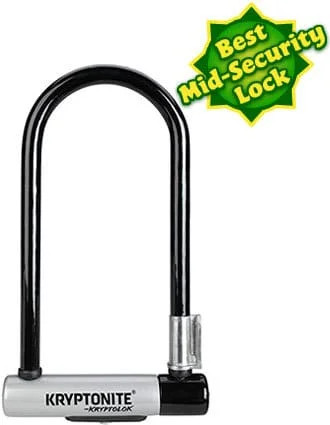 Kryptonite Kryptolok New-U best mid-security lock
Kryptonite Kryptolok New-U best mid-security lock
| Kryptonite Kryptolok New U |
|---|
| My score: |
| Check price: |
| Shackle thickness: |
| Weight: |
| Size (internal): |
| Kryptonite rating: |
| Other Security Ratings: |
While I personally prefer the keyhole covers found on OnGuard locks, which seem to mitigate disc misalignment, this is a minor critique (and OnGuard mechanisms generally offer less security).
Kryptonite’s customer service is arguably unmatched in the bike lock industry. This translates to numerous benefits, from complimentary key replacements to reduced-price or even free lock replacements under certain conditions.
For enhanced security within the Kryptonite range, consider their Evolution series. However, these locks will be either heavier or smaller and still lack angle grinder resistance.
However, for lower-risk environments, the Kryptonite Kryptolok provides a user-friendly bike lock with adequate protection at a very reasonable price.
For a comprehensive, hands-on review of the Kryptolok, including optimal alternatives if it’s not the right fit, refer to my detailed analysis.
3. Foldylock Compact
Folding locks are gaining traction as a popular alternative to traditional bike locks due to their enhanced portability and versatile locking options. However, the selection of truly secure folding locks is limited.
That said, some folding locks are definitely worth considering…
The Foldylock Compact stands out as the lightest folding lock that still provides a respectable level of security (Sold Secure Silver). Furthermore, among all the folding locks I’ve tested, it’s also the most user-friendly.
 Foldylock Compact: lightest folding lock
Foldylock Compact: lightest folding lock
Foldylock Compact: lightest folding good bike lock
The Foldylock Compact boasts a length of 33″ (85 cm), offering comparable internal locking space to a standard-sized u-lock. However, its flexible nature significantly expands your options when searching for a secure locking point.
Weighing in at just 2.2 lb (1 kg), it’s barely heavier than 2.5 cans of soda. For even greater weight savings, a slightly shorter (75 cm) version is available, also offered with a convenient belt clip, eliminating the need for a frame mount.
| Foldylock Compact |
|---|
| My score: |
| Check price: |
| Plate thickness: |
| Weight: |
| Length: |
| Foldylock rating: |
| Other Security Ratings: |
In comparison to its closest competitor, the Abus Bordo 6000 (until Abus lost its Sold Secure Silver rating), the Foldylock Compact is lighter and more intuitive to use.
It unlocks and unfolds more smoothly, offers greater flexibility around your bike, and includes a superior frame mount. Moreover, it is typically more affordable. Consult the Amazon price for up-to-date pricing.
If your security needs are moderate, and you seek a compact, flexible, and lightweight alternative to a u-lock, this is an excellent choice.
Delve into my hands-on review of the Foldylock Compact, where I also propose alternative bike locks if this model isn’t the perfect match. Alternatively, explore more options in my guide to the best lightweight bike locks.
4. Foldylock Forever
Foldylock also presents a high-security folding lock, the Foldylock Forever, essentially a reinforced, heavy-duty version of their standard folding lock range (Classic, Compact, Mini, etc.).
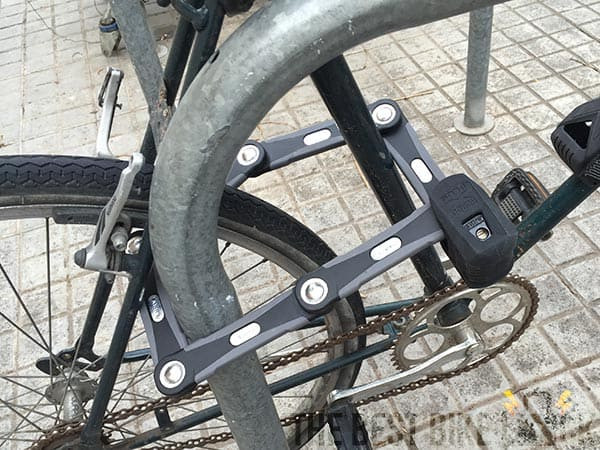 Foldylock Forever around traffic light
Foldylock Forever around traffic light
Foldylock Forever. You won’t get a u-lock around a traffic light!
Measuring 35.4″ (90 cm), slightly longer than the Foldylock Compact, it provides ample locking versatility. As illustrated above, it effortlessly secures a bike to a traffic light, an impossible feat for most u-locks.
Crucially, its arms are 6.5 mm thick, compared to 5 mm on standard Foldylocks. This added 1.5 mm contributes to its Sold Secure Gold rating, a step up from the Silver rating of other Foldylocks.
The Foldylock Forever’s arms are also 1 mm thicker than those of all other Sold Secure Gold-rated folding locks, including the Abus Bordo 6500, the Trelock FS 500 Toro, and the Kryptonite Evolution 790.
This enhanced thickness is coupled with a patented rivet protection system to deter nut splitter attacks. While such attacks are uncommon on the street, they are a recognized vulnerability of locks like the Abus Bordo 6500.
These enhanced security features make the Foldylock Forever the most secure folding lock currently available, and uniquely secure enough for mopeds and scooters in addition to bicycles.
| Foldylock Forever |
|---|
| My score: |
| Check price: |
| Plate thickness: |
| Weight: |
| Length: |
| Foldylock rating: |
| Other Security Ratings: |
This heightened security comes with a weight penalty. At 3.88 lb (1.76 kg), it’s a substantial lock, weighing slightly more than 4.5 cans of soda.
However, like all Foldylocks, it excels in usability. It’s easy to unlock, unfolds and refolds smoothly, and offers more internal locking space than a standard u-lock, providing numerous locking possibilities.
Despite some reviews suggesting mount fit issues, I experienced neither tightness nor looseness. Like the Classic, the Forever slides in and out of its plastic mount effortlessly, yet sits securely and rattle-free during cycling.
While not inexpensive, Amazon price checks typically reveal it’s more affordable than the Abus Bordo 6500 and other high-security folding locks. For comprehensive details, consult my hands-on Foldylock Forever review.
5. Kryptonite Kryptolok 955 Mini
For those favoring a more traditional bike lock, the Kryptonite Kryptolok Series 2 955 Mini is a compact, medium-security chain lock designed for portable security.
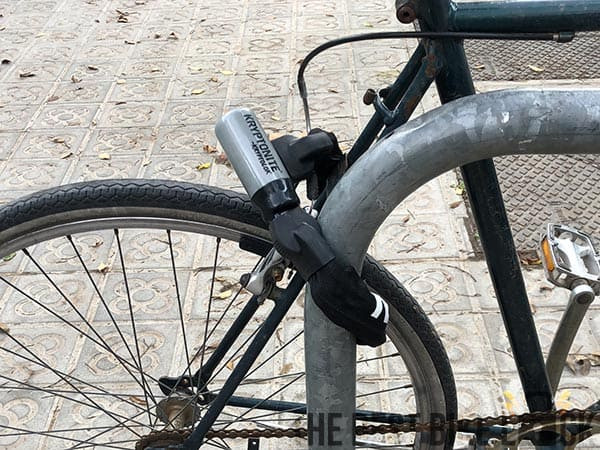 Kryptonite Kryptolok 955 Mini: best medium security chain lock
Kryptonite Kryptolok 955 Mini: best medium security chain lock
Kryptonite Kryptolok 955 Mini: best medium security chain good bike lock
When locked, its internal space is slightly less than a standard u-lock. However, its flexibility greatly expands the range of objects you can secure your bike to.
Like all chains, it’s heavier than a u-lock of comparable security (weighing about the same as 4.5 cans of soda). Yet, it remains light and compact enough to carry wrapped around your seat post or in a bag.
The integrated locking mechanism streamlines the locking process compared to chains with separate padlocks.
With 9 mm links, it’s not the most impenetrable bike lock, but it holds a Sold Secure Gold rating and offers significantly better protection than any cable lock.
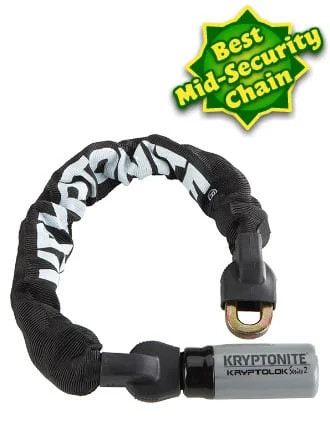 Kryptonite Krptolock Series 2 955 Mini best mid-security chain
Kryptonite Krptolock Series 2 955 Mini best mid-security chain
| KryptoLok Series 2 955 Mini |
|---|
| My score: |
| Check price: |
| Chain thickness: |
| Weight: |
| Length: |
| Kryptonite rating: |
| Other Security Ratings: |
Keep it elevated off the ground to minimize vulnerability to bolt cutters. Wrapping it around your seat stays, as shown, is recommended. Alternatively, secure it around your top tube and employ other methods to safeguard your wheels.
If you prioritize portability and prefer the enhanced locking versatility of a chain lock, and your risk level is not extreme, this is a reliable and affordable option.
For a similar yet more secure alternative, consider the Kryptonite Evolution Series 4 1055 Mini, featuring 10 mm links, a more robust body, and favored by the Lock Picking Lawyer.
Read my hands-on review of the Kryptonite Kryptolok Series 2 955 Mini. For broader chain lock considerations, explore my comprehensive guide to chain locks.
6. Litelok Core Plus
A significant challenge with bike locks is convenient portability. Locks are often bulky and heavy. Frame mounts can be aesthetically unappealing and unreliable. Larger, more versatile locks exacerbate these issues.
Enter “wearable” bike locks.
The Litelok Core Plus is the most secure wearable bike lock currently available, boasting a Diamond rating from Sold Secure.
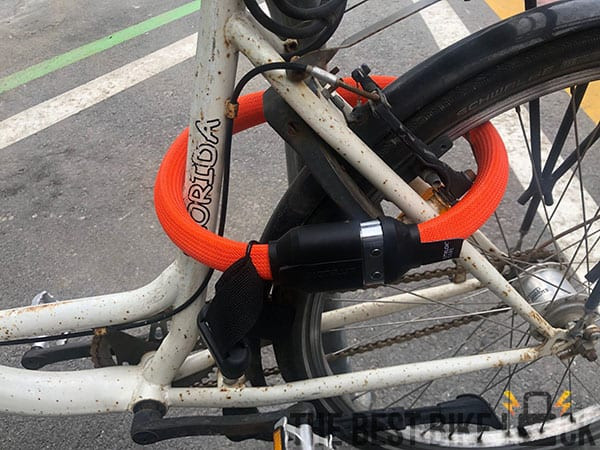 Litelok Core around bike frame and back wheel
Litelok Core around bike frame and back wheel
Litelok Core Plus: strongest wearable good bike lock
Liteloks are constructed from “Boaflexicore,” a complex cable composite distinct from typical cable locks. The Litelok Core Plus utilizes an upgraded Boaflexicore Plus, specifically engineered to resist advanced cable cutters.
In practical terms, only an angle grinder is likely to penetrate the Litelok Core.
The standout feature of the Litelok Core Plus is its portability – it can be worn around your waist like a belt when not securing your bike. While not the first lock with this functionality (the Hiplok Gold chain is also wearable), the Litelok Core Plus surpasses the Hiplok chain in several aspects.
Firstly, it offers superior security. The Hiplok has a lower Sold Secure Gold rating and is vulnerable to bolt cutters, which pose no threat to the Litelok Core. Secondly, the Litelok is lighter and more comfortably worn around the waist.
| Litelok Core Plus |
|---|
| My score: |
| Check price: |
| Waist Size |
| Weight: |
| Length: |
| Other Security Ratings: |
It’s not without minor drawbacks. Positioning the Litelok’s end through wheel spokes can be slightly awkward in some situations. While available in two lengths, wearing it as a belt restricts you to the waist-fitting size.
Nevertheless, no other Diamond-rated lock offers comparable portability. Even the smaller Litelok Core provides a generous locking circumference, offering ample options for securing your bike.
Wearing a bike lock as a belt isn’t for everyone (it can also be frame-mounted). However, if it suits your lifestyle, the Litelok Core Plus is a highly secure and versatile choice. Refer to my comprehensive hands-on review of the Litelok Core Plus for further insights.
How to choose the right good bike lock for you
If none of my top 6 recommendations feel quite right, don’t be discouraged! By continuing to read, I’ll guide you through 3 straightforward steps to guarantee you find the perfect lock for both you and your bicycle.
As previously mentioned, the best bike locks not only safeguard your bike but also integrate seamlessly into your daily routine.
Your personal circumstances are crucial considerations. These include the type of bike you own, its value, your usage patterns, and your budget.
This might seem like a lot to consider, but these 3 steps simplify the process:
- Choose the right level of security
- Choose the right type of lock
- Choose the right size lock.
Step 1 will help you determine your required security level and identify locks that offer the appropriate protection.
In Step 2, I’ll introduce various bike lock types and guide you in selecting the lock type that best aligns with your individual needs.
Finally, Step 3 will explain how to choose the correct size lock for your bike type and preferred locking method.
table of contents
Step 1: Choose the right level of security
Step 2: Choose the right type of bike lock
Step 3: Choose the right size lock
Which company makes the best bike locks?
Do bike thieves use lock picking techniques?
What’s the strongest bike lock?
What’s the lightest bike lock?
How can I protect my bike wheels and seat?
What’s the best way to lock my bike?
Ready to begin? Let’s get started!
Step 1: Choose the right level of security
The primary function of any lock is to prevent bike theft. Therefore, the first and most critical step is to determine the necessary level of protection.
However, simply opting for the strongest lock isn’t always optimal. Increased security in bike locks often translates to greater weight or reduced size, or both.
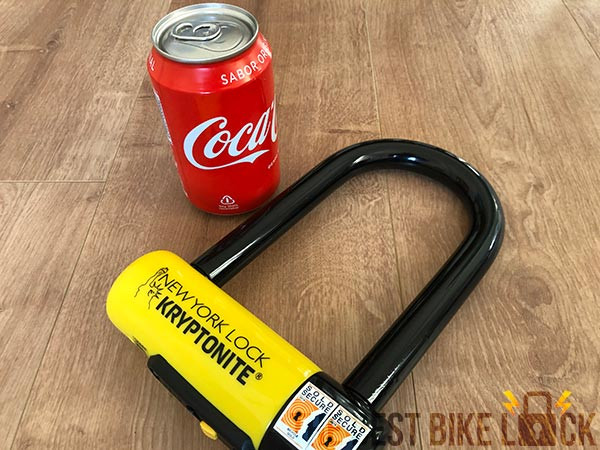 Kryptonite Fahgettaboudit Mini
Kryptonite Fahgettaboudit Mini
Kryptonite Fahgettaboudit Mini: very strong, but also very small and very heavy
Choosing an insufficiently secure lock makes your bike an easy target. Conversely, selecting an overly secure lock for your circumstances can result in unnecessary weight or size limitations, impacting practicality without added benefit. This might lead to improper or infrequent use, ironically increasing theft risk.
Matching your lock’s strength to your actual risk level is crucial. The easiest way to assess this is by answering the 3 questions in this quiz…
If you’ve completed the quiz, you’ll have received a recommendation for a Sold Secure Silver, Gold or Diamond rated bike lock.
You might now be wondering, “Who or what is Sold Secure?”
Who are Sold Secure?
Sold Secure is an independent organization that rigorously tests and rates bike locks and other security products based on their level of protection.
Sold Secure rate locks from Bronze to Diamond depending on how long they take to defeat.
Bike locks are categorized from Bronze (least secure) to Silver, Gold, or Diamond (most secure), based on their resistance to attack in the Sold Secure workshop:
- Diamond locks: “provide the highest level of security … aimed at very high value bicycles and e-bikes.”
- Gold locks: “offer the next highest level of security, aimed at mid-to-high value bicycles.”
- Silver locks: “offer a compromise between security and cost.”
- Bronze locks: “typically offer defence against the opportunist thief.”
Why should we trust Sold Secure?
Sold Secure conducts more bike lock testing and rating than any other entity. They adhere to standardized tools and methodologies informed by real-world thief tactics, encompassing both brute force and picking techniques.
They maintain close collaboration with law enforcement and insurance companies to ensure their testing methods remain current. Locks must be resubmitted for annual testing to retain their rating.
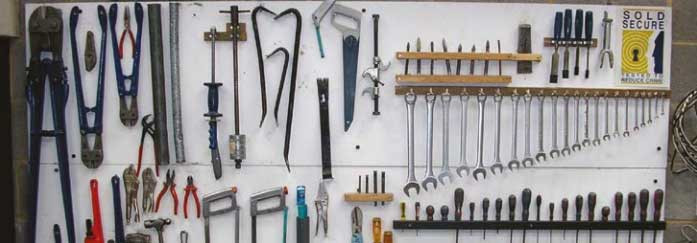 The Sold Secure Lab
The Sold Secure Lab
Inside the Sold Secure workshop
Most insurance providers mandate the use of a Sold Secure rated lock for coverage, with the required rating level depending on the policy. Failure to use a Sold Secure rated lock may invalidate your insurance.
These factors establish Sold Secure ratings as trustworthy. They possess demonstrable expertise.
However, other metrics exist for assessing bike lock strength, and these deserve consideration as well.
Other Independent Testers
Sold Secure is not the sole independent body evaluating bike locks. In the Netherlands, ART offers a similar service, rating locks from 1 to 5 (5 being the strongest) based on their attack resistance.
ART use a 1-5 star system and are more strict but rate less locks than Sold Secure
ART employs both machine testing (tensile strength, torsion strength, cutting, corrosion, dust, and freeze tests) and engineer evaluations (brute and intelligent attack tests) to formulate their ratings:
- 1 star: Minimum security (“take away security”)
- 2 stars: Bicycles
- 3 stars: Mopeds and scooters
- 4 stars: Motorcycles (on the road)
- 5 stars: Motorcycles (parked at home)
Sold Secure vs ART
ART tests and rates fewer locks than Sold Secure, and their classification system is more granular. However, their ratings can be used in conjunction with Sold Secure to gain a more refined understanding of a lock’s security level.
For instance, if two locks both achieve a Sold Secure Gold rating, but one has 2/5 stars from ART while the other has 3/5 stars, the latter is demonstrably more secure.
This is a common scenario and a valuable method for further differentiating locks based on security.
Online Tests (are a bit rubbish)
Numerous cycling and product review websites publish articles detailing their lock attack attempts using various tools, aiming to identify the “best” lock.
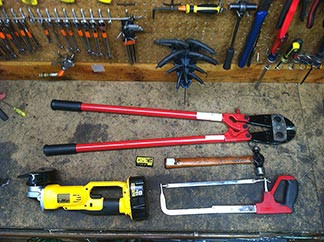 Lock testing tools
Lock testing tools
Tools used to test good bike locks
While these articles can be entertaining, several limitations warrant caution:
They test a limited number of locks, lack standardized tools and methods, and without insider knowledge, may not replicate real-world thief attack strategies. This makes result reliability questionable.
Crucially: defeating a lock with a tool not used by thieves is irrelevant. Thieves carry a limited toolkit (cable cutters, medium bolt cutters, pry bars, and angle grinders). They don’t use nut splitters or drills (anymore), and they don’t pick locks!
These tests often neglect practicality aspects like portability and ease of use, which are critical as there is no “one-size-fits-all” lock.
Beyond the consensus that “cable locks are rubbish” and “angle grinders defeat everything,” their conclusions are neither definitive nor particularly helpful. Numerous recommendations on prominent websites are demonstrably flawed, eroding trust in their assessments.
Lock Brand Ratings (are confusing)
Leading brands have developed proprietary rating systems to facilitate security level comparisons within their own product lines.
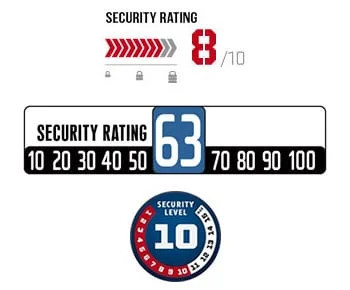 Different lock brand security ratings
Different lock brand security ratings
Kryptonite, OnGuard and Abus all use different security ratings. Confused?
While useful for intra-brand comparisons, these disparate systems are ineffective for comparing locks across different brands.
How I use the Sold Secure Ratings
The takeaway is: determine your risk level using the quiz above. “High risk” scenarios necessitate Gold or Diamond rated locks. “Lower risk” situations may be adequately addressed by Silver rated locks.
| If your risk level is: | High Risk | Lower Risk |
|---|---|---|
| Your lock security rating should be: |
I advise against Sold Secure Bronze locks in any circumstance due to their minimal practical protection. While potentially adequate in extremely low-risk areas, I am hesitant to recommend locks so easily compromised.
The extensive variety of locks available across different sizes, weights, and price points ensures you can find a Sold Secure Silver or better rated lock that meets your specific needs.
Step 2: Choose the right type of good bike lock
This step is almost as vital as Step 1. The chosen lock type directly impacts usability. A cumbersome lock will deter consistent use, increasing theft vulnerability.
Avoid locks that are excessively heavy, small, difficult to carry, complicated to secure, or that severely restrict locking locations.
This is inherently dependent on individual circumstances. However, examining the pros and cons of each lock type will clarify the optimal choice for you.
Four established bike lock types exist:
-
U-locks
-
Chain locks
-
Folding locks
-
Cable locks
Each lock type represents a compromise across three core attributes:
- Price
- Practicality
- Security
The crucial takeaway from this chart is that while u-locks, chain locks, and folding locks offer a reasonable balance of price, practicality, and security, cable locks do not.
While cable locks may be inexpensive and easy to use, they provide minimal security. Therefore…
Avoid cable locks!
To determine the best option among the others, let’s examine each type in detail.
U-locks / D-locks
U-locks (also known as D-locks) function like oversized padlocks, securing your bike to fixed objects.
| U-locks: pros and cons |
|---|
| – Cheaper than chain locks – Lighter than chain locks – More secure than folding locks |
Quality u-locks provide a favorable balance of price, practicality, and security. They are generally cheaper, lighter, and slightly more user-friendly than chain locks, while maintaining a high level of protection.
Their rigid nature can make them less portable than chain locks. Their limited size and shape also restrict the range of objects you can secure your bike to.
However, generally, if you’re investing in a single bike lock, a u-lock is recommended.
Price points range from around $30 / £18 for a decent budget lock to $300 / £300 for the most robust and secure models, ensuring options for various budgets.
However, consider several factors before purchasing a u-lock, including size requirements and portability solutions.
The two u-locks recommended at the top of this page are standard size. This means they’re large enough to fit around a wide array of objects, making them suitable for most cyclists, regardless of bike type or locking habits.
This versatility is why I recommend them.
However, other u-lock sizes exist, with smaller sizes gaining popularity. Let’s briefly examine one of the best smaller u-locks…
Kryptonite New-U Evolution Mini-7
The Evolution Mini-7 is Wirecutter’s top lock recommendation and a superb lock. However, it isn’t universally suitable.
| Kryptonite New-U Evolution Mini-7 |
|---|
| My score: |
| Check price: |
| Shackle thickness: |
| Weight: |
| Size (internal): |
| Kryptonite rating: |
| Other Security Ratings: |
The Mini-7 offers numerous appealing features. Its 13 mm shackle is crafted from Kryptonite’s strongest “max performance” steel and locks into the crossbar on both sides. This enhances resistance to both cutting and leverage attacks, reflected in its Gold rating from Sold Secure.
It includes a cable to secure the wheel not protected by the u-lock, and a reasonably effective frame mount (when properly installed).
It’s more secure than the Kryptonite Kryptolok and lighter than the Litelok X1 and many other Gold and Diamond rated locks (weighing less than 3 cans of soda without the cable).
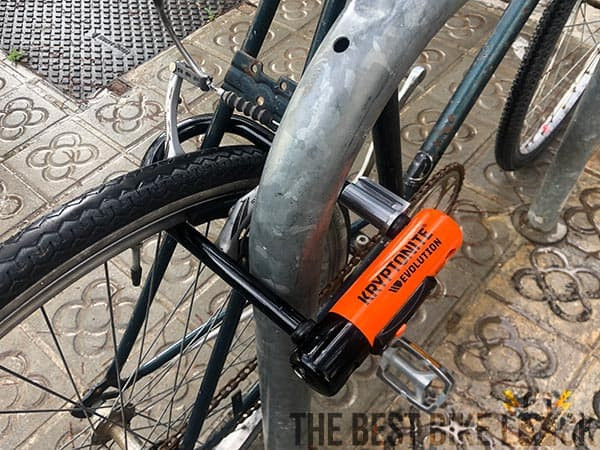 Kryptonite Evolution Mini-7
Kryptonite Evolution Mini-7
Kryptonite Evolution Mini-7: it won’t be for everyone
However, consider these points before purchasing:
Firstly, despite its Sold Secure Gold rating, it only received 2/5 stars from ART, placing it at the lower end of the Gold spectrum. It’s still very secure, just not among the absolute top tier. It certainly offers no resistance to angle grinders.
Secondly, it is a mini u-lock. This significantly narrower profile limits its use primarily to bike racks. Depending on your bike, you may not achieve your desired locking method.
For example, bikes with wider tires or thicker frames might prevent fitting the lock around the wheel, frame, and rack simultaneously.
However, with flexibility and adjusted locking techniques, this lock can securely protect any bike type on a rack.
I personally appreciate this lock for its suitability to my needs. However, its bike rack restriction makes it difficult to universally recommend as ideal for everyone.
Read my full review of the Kryptonite Evolution Mini-7.
Chain locks
Chain locks typically consist of a long metal chain (protected by a sleeve to prevent paint damage) and a substantial lock.
| Chain locks: pros and cons |
|---|
| – Easier to carry than u-locks – Fasten around more objects than u-locks |
Chain locks broadly fall into two categories:
- Portable chains: Light enough for daily carry.
- Stationary chains: Too heavy for routine portability, best suited as fixed security (> 12 mm link thickness).
Portable Chains
These are conveniently carried wrapped around your seat post or in a bag. Their length and flexibility allow securing your bike to diverse objects.
However, these chains are generally limited to 12 mm thickness and are less secure than quality u-locks. They are also significantly heavier.
Stationary Chains
An extremely thick, core-hardened steel chain with a heavy-duty, top-tier padlock represents perhaps the most secure method for locking your bike.
However, these chains are so heavy and cumbersome that they are best utilized as a secondary, stationary lock, left at locations where your bike is regularly secured for extended periods.
Chain lock prices range from approximately $45 / £40 for a short, budget model to $500 / £200 for the thickest, heaviest options, making them generally more expensive than u-locks.
As with u-locks, carefully consider your size and thickness needs, and portability solutions if a portable chain is required.
The two chains I recommend at the top of this page (the Kryptolok and Evolution) are suitable for portable security. Let’s examine the best stationary chain lock option…
The Strongest Static Chain Lock: Kryptonite New York Legend 1515
While Pragmasis arguably produces the strongest chain locks, their limited global availability makes the Kryptonite New York Legend Chain 1515 the most secure globally accessible bike chain lock.
| New York Legend 1515 |
|---|
| My score: |
| Check price: |
| Chain thickness: |
| Weight: |
| Length: |
| Kryptonite rating: |
| Other Security Ratings: |
With 15 mm links, portability is not a consideration. This lock remains at your regular locking location, securing your bike throughout the day or night.
It boasts a 5/5 ART rating, a rare distinction. Available in two lengths (5′ and 3′), it can secure single or multiple bikes.
For ultimate security in your bike shed or other bike storage solution, this is a fantastic, albeit expensive, choice.
I’ve written a full review of the New York Legend Chain 1515. I also compare it to other chain locks as well.
Folding Locks
Folding locks consist of interconnected metal plates joined by rivets. They collapse into a compact form for transport and unfold to create a flexible shape for securing your bike.
| Chain locks: pros and cons |
|---|
| – Easiest to carry – Fasten around more objects than u-locks – Quite light |
They are generally slightly heavier than u-locks offering comparable security. However, their length and flexibility provide more locking options than standard-sized u-locks.
Their primary advantage is their compact folded form, making them exceptionally easy to transport.
The carrying holster can attach via Velcro to your frame or, ideally, screw into your bottle holder mounts.
Folding locks are really compact and easy to transport!
This compact design prevents loosening, swinging, or general interference with your ride, issues sometimes encountered with u-locks.
While potentially less intuitive to lock than u-locks or chains (unfolding and maneuvering around your bike and the locking object can be slightly cumbersome), folding locks offer excellent portability.
Concerns exist regarding their long-term durability after attempted theft due to their relatively complex construction.
However, if you are dissatisfied with u-lock frame mounts, folding locks are a compelling alternative.
Cable locks (are rubbish!)
Cable locks are typically composed of numerous thin steel strands braided together within a plastic tube.
| Cable locks: pros and cons |
|---|
| – Long – Light – Cheap – Practical |
They are lightweight, flexible, and generally inexpensive. However, this flexibility equates to softness, rendering almost all cable locks vulnerable to handheld cable or bolt cutters, often defeated in seconds.
Given that cable cutters are a near-universal tool among bike thieves, cable locks offer negligible practical security.
Bike thieves actively target these locks. Bike theft statistics in both the US and UK suggest that approximately 90% of stolen bikes were secured with cable locks.
Avoiding cable locks significantly reduces your bike theft risk.
While cable locks can serve as secondary locks for wheels or saddles, superior methods exist for securing these components.
Innovative Locks
One additional bike lock category exists: innovative locks. These often originate from individual inventors and gain initial funding through crowdfunding platforms like Kickstarter.
| Innovative locks: pros and cons |
|---|
| – Address known issues with other types of lock – Use new technology |
Unfortunately, many innovative locks neglect security validation (a critical oversight for security products) and lack testing and ratings from Sold Secure or ART.
However, some innovative locks have undergone testing and rating and warrant consideration, such as the titanium TiGr Mini and the textile Tex-lock.
Be aware that innovative locks tend to be more expensive than their security level justifies and should only be considered if they address specific usability needs unmet by conventional locks.
U-locks vs Chain locks vs Folding locks
I discuss the pros and cons of u-locks and chains in greater detail on the u-lock vs chain lock page. Here’s a summary:
Portable Security
For everyday carry, u-locks are generally the optimal choice.
Typically lighter, cheaper, and more secure than portable chains, they achieve the best balance of security, practicality, and price.
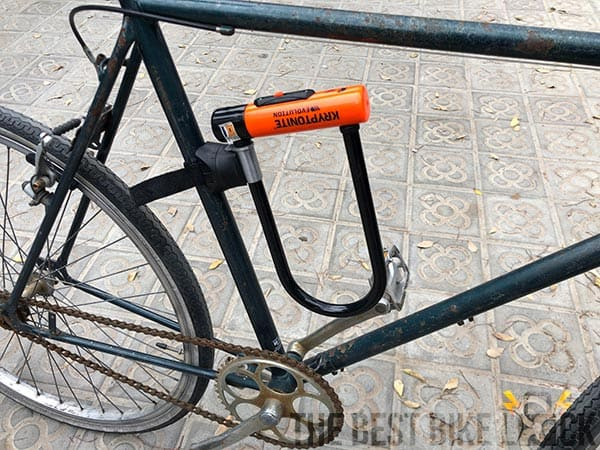 Kryptonite Evolution Standard
Kryptonite Evolution Standard
U-locks are generally the best choice for portable security
Valid reasons may exist to prefer a chain over a u-lock. Perhaps you require greater locking versatility than a u-lock offers, or you dislike u-lock frame mounts.
However, u-locks are typically the best choice for portable security in most scenarios.
Stationary Security
For fixed locations like home or work, a large, heavy chain is preferable. A thick chain paired with a robust lock provides the highest level of bike security.

High security chains are the best choice for stationary security at home or work.
They are more resistant to power tool attacks, impervious to bolt cutters (at 16 mm thickness or greater), and immune to bottle jack attacks. A single chain can secure multiple bikes, and they are more compatible with ground anchors.
However, avoid attempting to carry them for quick errands!
What about Folding Locks?
Like u-locks, folding locks are best suited for portable security. They address two primary u-lock drawbacks: rigid shape and transport difficulties.
Their flexibility expands locking options compared to standard u-locks. Their compact folded form makes them significantly easier to transport. They also compete with u-locks in weight (though typically slightly heavier).

Folding locks: more expensive and not as secure but more portable than u-locks
However, high-security folding locks are less secure than high-security u-locks and more expensive. Furthermore, limited high-quality folding lock manufacturers (Abus, Seatylock, Trelock, and Kryptonite) restrict your choices.
If u-locks don’t meet specific needs, consider a folding lock before a chain lock.
Step 3: Choose the right size good bike lock
Once your required security level, preferred lock type, and brand are determined, consider lock size. Size significantly impacts usability and practicality.
In an ideal scenario, we’d all use the smallest, lightest bike lock possible. This might suffice for slim road bikes or single-speeds in cities with abundant slim bike racks.
However, bulkier ebikes, mountain bikes, or cruisers, and areas lacking bike racks necessitating reliance on lampposts or railings, demand larger locks.
Your bike locking method also influences size. Conventional wisdom dictates securing both frame and rear wheel with your lock, requiring a larger locking circumference.
However, alternative wheel security methods exist. If your lock only needs to encircle the frame, a smaller lock can suffice even on larger bikes. Consider your locking strategy before purchasing.
Generally, larger bikes (ebikes, mountain bikes, cruisers, city bikes, comfort bikes, tandems, BMXs) necessitate a locking circumference comparable to a standard u-lock (around 85 cm).
Slender bikes (road bikes, hybrid bikes, fixies/single speeds) are more likely to accommodate mini u-locks and smaller folding locks.
Personal circumstances heavily influence size requirements, so careful consideration is advised.
Which company makes the best good bike locks?
Having narrowed down security level, lock type, and size, you’ll likely encounter numerous similar locks from various brands. How do you choose between them? Let’s examine three prominent brands:
Abus vs Kryptonite vs OnGuard
I delve into this in detail on the Abus vs Kryptonite vs OnGuard page (including a comprehensive review of “Anti-theft Protection” schemes). Here’s a summary:
Abus produces the highest quality locks. They are well-crafted, rigorously tested, highly reliable (even in harsh weather), and durable. However, they are the most expensive of the three brands.
Kryptonite also manufactures high-quality locks, not quite matching Abus’s standard, but compensated by exceptional customer service, including free key and lock replacements in certain situations and the best anti-theft protection schemes.
OnGuard has a somewhat weaker reputation for build quality and customer service. However, they have significantly improved lock quality in recent years and offer the most competitive pricing (OnGuard locks are consistently the cheapest!).
For top-tier quality, choose Abus. For the best price, consider OnGuard. For superior customer service, Kryptonite is recommended.
Other good bike lock brands
While the “big three” are most recognized, numerous other worthy lock brands exist.
In fact, in 2024, my top 6 picks include more niche brands than established ones, with two locks each from Litelok and Seatylock (Foldylocks).
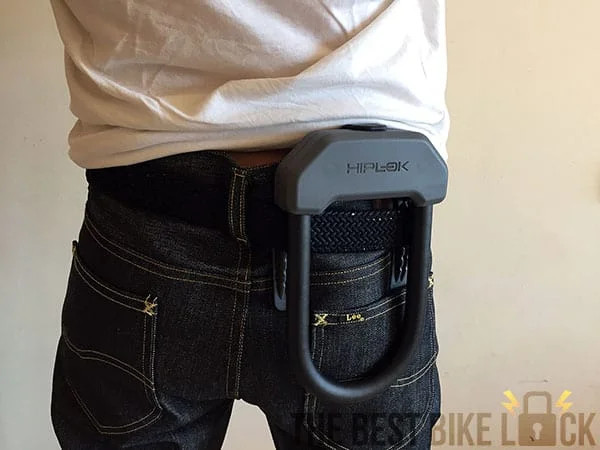 The Hiplok attached to my belt
The Hiplok attached to my belt
The Hiplok attached to my belt
Hiplok is another brand specializing in wearable bike locks, including chains worn around the waist and u-locks clipped to belts, prioritizing convenient lock transport.
Interestingly, significant innovation originates from these smaller brands, although larger brands are likely to adapt and catch up.
Making the Final Decision
Following these three steps should provide a clear understanding of the security level, lock type, size, and brand best suited to your needs.
If none of my 6 recommendations align with your preferences, browse comprehensive lists of Sold Secure Silver, Gold, or Diamond bike locks based on your risk level, comparing sizes, weights, and prices until you find the perfect match!
How much money should I spend?
As with most purchases, higher spending generally equates to better lock quality. But what constitutes “quality” in bike locks?
Primarily, quality translates to reliability, a crucial attribute for bike locks.
Avoid locks with keys that malfunction, mechanisms that jam, or shackles that stick. Malfunctioning locks can cause significant issues.
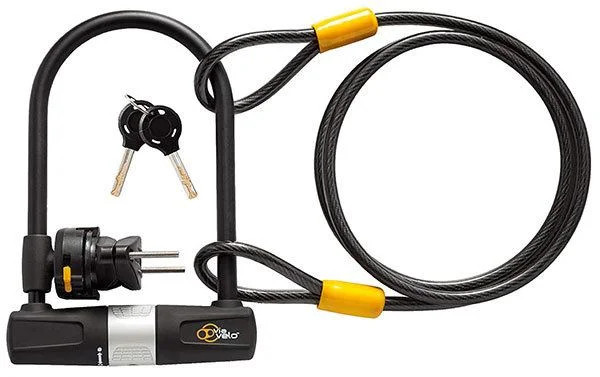 Cheap u-lock
Cheap u-lock
Cheap u-locks can be secure but are often unreliable: check the reviews
If a lock malfunctions while securing your bike, your bike becomes unusable until the lock is removed (potentially problematic). If malfunction occurs before locking, your bike may be stolen.
Higher-quality locks reduce these risks.
Regarding price and security, while cheap, high-security locks and expensive, low-security locks exist, generally, higher security locks cost more. Reliable, high-security locks always cost more!
 How much money should I spend?
How much money should I spend?
Spend as much as you can afford: it will be cheaper in the long run
Many lock brands recommend allocating 10% of your bike’s value to the lock. However, spending only $20 on a lock for a $200 bike is likely insufficient.
Spend as much as your budget allows. This maximizes reliability and security, providing peace of mind.
Remember, a quality bike lock can last for years and across multiple bikes. Even if you currently own an inexpensive bike, a future upgrade won’t necessitate purchasing a new, better lock.
Purchasing a bike lock isn’t exciting, and the expense of protecting your property is frustrating. However, a cheap lock is false economy.
A jammed lock necessitates professional removal and replacement costs. Bike theft leads to replacement bike and lock expenses.
Learn from experience and invest wisely initially!
Frequently Asked Questions
This final section addresses common questions about bike locks, separated from the main article for conciseness but potentially valuable for informed decision-making.
Do bike thieves use lock picking techniques?
No, most bike thieves lack lock-picking expertise, even for basic locks. Brute force methods suffice for most basic bike locks.
While a small fraction of thieves may possess rudimentary lock-raking skills, their limited expertise and prevalence make it a negligible concern with a reasonably decent lock.
Celebrity lock pickers like Bosnian Bill and the Lock Picking Lawyer are highly skilled experts using specialized tools in controlled environments. Their rapid lock openings don’t translate to real-world street conditions.
While the Lock Picking Lawyer opened one of my favorite locks in under 90 seconds in the video below, he acknowledges its “enough pick resistance to use in the street” due to the lack of specialized tools and skills among street thieves.
However, understanding lock mechanism types is beneficial when choosing a bike lock. Four common types exist: disc detainer, slider, pin tumbler, and wafer.
Disc detainer mechanisms, pioneered by Abloy and increasingly used in high-quality locks like Abus and Kryptonite, are durable and generally pick-resistant.
Slider mechanisms, characterized by keys with straight edges and internal teeth, are increasingly used in budget locks like OnGuard and Zefal. Pick resistance varies depending on implementation.
Pin tumbler and wafer mechanisms are generally less secure due to susceptibility to raking attacks requiring minimal skill. Wafer mechanisms are particularly vulnerable and best avoided.
What’s the strongest good bike lock?
The strongest bike locks are the Litelok X3 or Hiplok D1000. In my tests, the Litelok X3 marginally outperformed the Hiplok D1000.
Both offer exceptional angle grinder resistance, approaching angle grinder proof in most real-world scenarios.
However, both are very heavy and prohibitively expensive. The Litelok X1 offers a more practical balance, providing significant angle grinder resistance while being lighter, better sized, and more affordable.
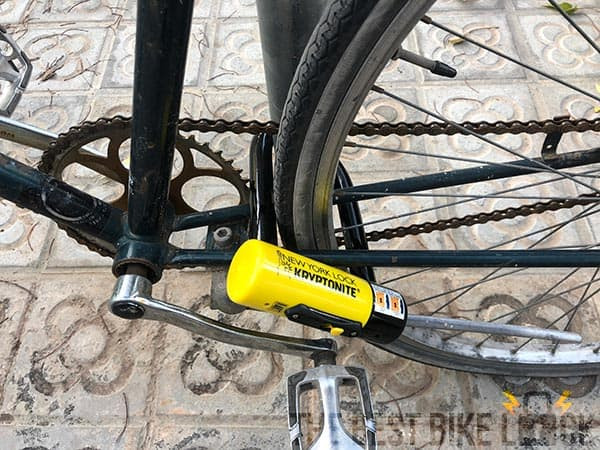 Kryptonite Fahgettaboudit Mini frame and wheel
Kryptonite Fahgettaboudit Mini frame and wheel
Litelok X1: almost angle grinder proof!
It is also the only angle grinder resistant lock that comes with a frame mount! See my Litelok X1 review for complete details and my angle grinder test video.
I’ve written an entire article about the strongest bike locks. Remember that increased bike lock strength often coincides with increased weight and/or reduced size, frequently both.
What’s the lightest good bike lock?
The lightest bike lock I recommend is the TiGr Mini. However, it’s not universally suitable. Lightweight locks often sacrifice security or size, or are very expensive. “Lightweight” is subjective in bike locks.
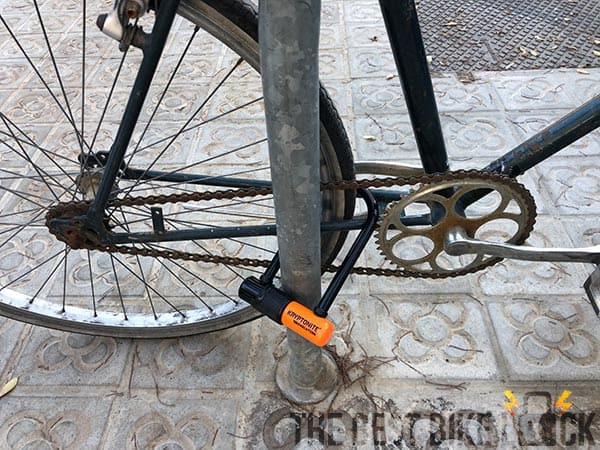 Kryptonite Evolution LITE Mini-6
Kryptonite Evolution LITE Mini-6
Kryptonite Evolution LITE Mini-6: weighs less than 2 cans of Coke
Prioritize security over mere weight. Carefully compare weight, size, and price of any “lightweight” lock to ensure the trade-offs align with your needs.
I’ve also written a comprehensive article about the lightest bike locks for further guidance.
How can I protect my bike wheels and seat?
Bike wheel and seat protection can be achieved through various security devices, including additional locks, cable lassos, security skewers, hex bolt blockers, and DIY methods.
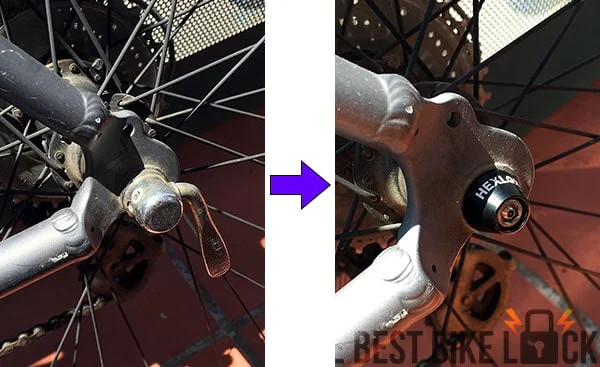 Hexlox wheel skewer
Hexlox wheel skewer
Hexlox are one way to protect your wheels
My extensive article on the best ways to secure your bike wheels and seat explores all available options.
What’s the best way to lock my bike?
No single “best” bike locking method exists. However, numerous ineffective methods guarantee theft.
My detailed article on how to lock a bike covers effective and ineffective techniques. Review this before finalizing your lock choice.
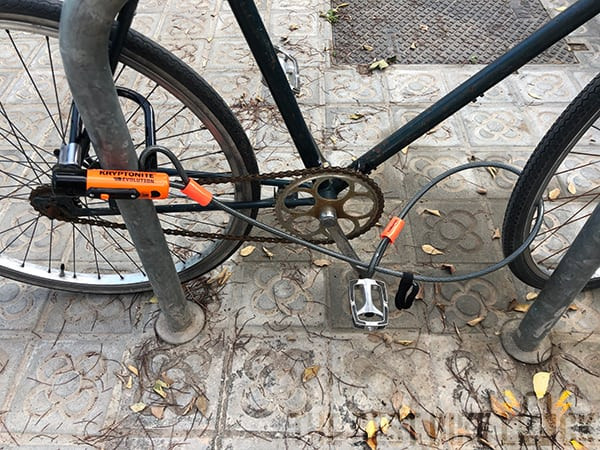
There are several perfectly secure ways to lock a bike (and many insecure methods too)
You may discover secure locking methods previously unknown or underestimated. Understanding these techniques can enable choosing a more user-friendly lock, as valid methods might allow using a smaller and lighter model!
This page contains affiliate links, which means I may earn a small commission if you click through and make a purchase. You will not pay any extra. More details here.
More Good Stuff:
Sold Secure Gold Bike Locks: The List
 Win a Free Bike!
Win a Free Bike!
Win a Free Bike!
How to lock you bike (properly)

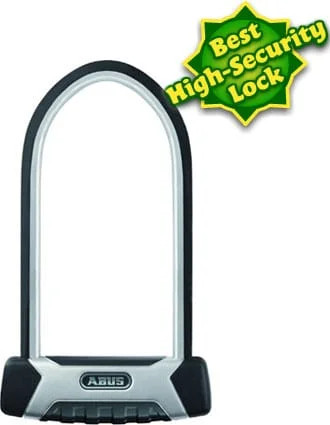 Litelok X1: Best Bike Lock
Litelok X1: Best Bike Lock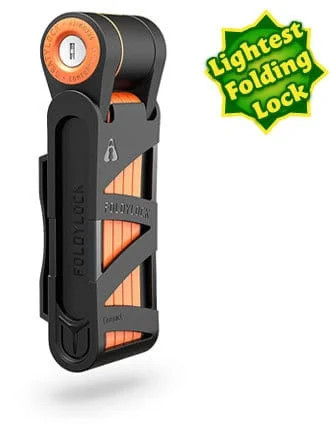 Foldylock Compact
Foldylock Compact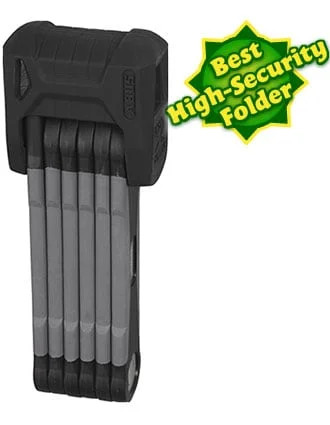 Foldylock Forever
Foldylock Forever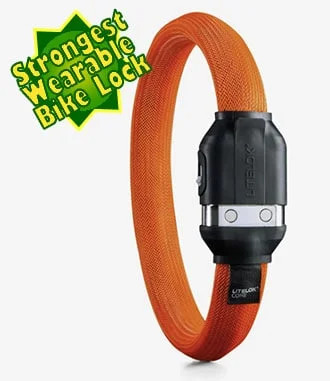 Litelok Core
Litelok Core
